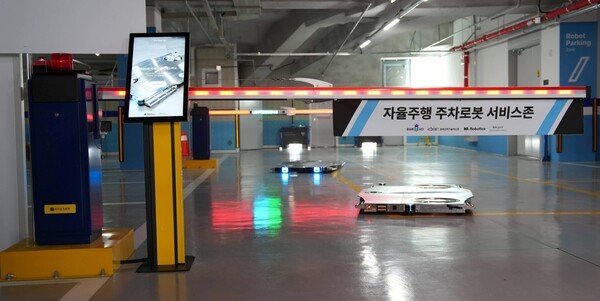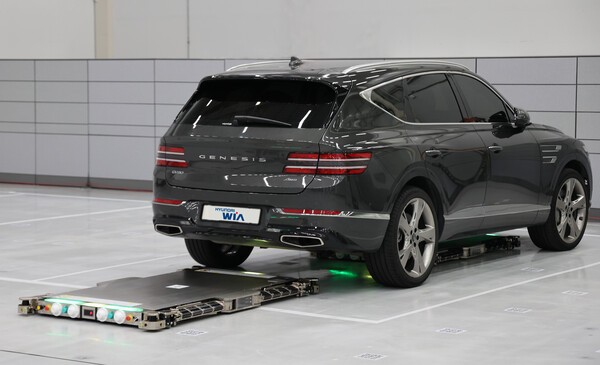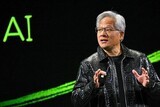AI and Robotics Join Forces for Automated Parking… A Revolution in Urban Space Utilization
Parking lots are no longer spaces of stress for drivers. As Kakao Mobility and Hyundai Wia begin to demonstrate and commercialize robotic parking technologies, the shift toward “robots parking cars instead of humans” is accelerating. The fusion of artificial intelligence (AI) and robotics in automated parking solutions is poised to become a key pillar of future smart city infrastructure.

Kakao Mobility Launches Pilot of Robot Valet Parking Service
On October 15, Kakao Mobility unveiled its Robot Valet Parking service, marking a new step in next-generation mobility infrastructure testing. Drivers simply stop their cars at the entrance — from there, robots take over.
Once vehicle information is entered via a kiosk, two parking robots move underneath the vehicle, lifting and automatically maneuvering it into the designated parking space with precision.
The system is also integrated with KakaoTalk, allowing users to easily request vehicle retrieval.
The pilot program is currently being operated for building tenants, with plans to expand service access to the general public. A company representative stated, “Robot Valet Parking will not only solve the complex parking challenges of urban areas but also redefine human-centered mobility experiences.”

Hyundai Wia and Hyundai Engineering & Construction Sign MOU for “Robot-Optimized Parking Facilities”
Infrastructure development is ramping up in tandem with the spread of robotic parking technology. On November 7, Hyundai Wia and Hyundai E&C signed a memorandum of understanding (MOU) at the Uiwang Research Center to jointly develop robot parking solutions.
Under this agreement, the two companies will collaborate on “robot-optimized parking lots.” Hyundai E&C will identify new business sites suitable for robotic operations and handle structural design, while Hyundai Wia will focus on robot control software and user experience (UX) / interface (UI) design.
The newly showcased parking robot from Hyundai Wia can move vehicles weighing up to 3.4 tons and is based on technologies already commercialized at Factorial Seongsu and Hyundai Motor Group’s Meta Plant America (HMGMA).
A Hyundai Wia spokesperson said, “Through robotic parking solutions, we aim to ensure both spatial efficiency and safety, setting the standard for future urban parking.”
Robots Reshaping Urban Design: The Dawn of Smart Infrastructure
Experts believe robotic parking technology will serve as more than a mere convenience — it will mark a turning point in urban spatial restructuring.
Parking robots can increase parking efficiency by up to 40% by minimizing gaps between vehicles. They also help reduce accidents by eliminating unnecessary human movement and lower operational costs through IoT-based integrated management.
As a result, parking lots are transforming from static structures into intelligent mobility systems. By integrating AI, robotics, and big data, these systems have the potential to reshape urban traffic flow and architectural design patterns.
The Concept of Parking Is Changing: From “Driving” to “Automation”
Kakao Mobility’s Robot Valet Parking and Hyundai Wia’s Robot Parking Facility Project are being hailed as tangible models for realizing a Korean-style smart city.
Once robotic parking becomes mainstream, the turning radius, parking routes, and infrastructure layouts of vehicles will all change — ultimately enhancing urban space efficiency and paving the way for a sustainable, eco-friendly city ecosystem.
The traditional concept of a “driver-managed parking space” is being replaced by a robot-managed system. The future of parking has already begun — not inside the parking lot, but within the realm of technology.
Tech Insider Columnist | tlswnqor@naver.com

![[동학] 카카오톡 친구탭, 결국 12월 롤백… “격자형 피드는 선택 옵션으로”](https://cdn.kmjournal.net/news/thumbnail/custom/20251126/5517_10550_1119_1763853080_120.jpg)


![[테크 칼럼] 제미나이3, GPT-5.1을 넘다…AI는 이제 ‘일을 대신하는 시대’로 간다](https://cdn.kmjournal.net/news/thumbnail/custom/20251126/5457_10454_4847_1763621329_120.jpg)



![[낭만 테크 시대] AI 대항해 시대](https://cdn.kmjournal.net/news/thumbnail/custom/20251126/5603_10714_4334_1764121414_160.jpg)

